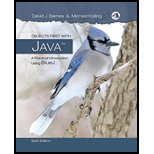
Program plan:
The variables used in the program are given below:
- item: SalesItem - an instance of the SalesItem class, which represents a sales item being sold on a website or in a store.
- comment1: Comment - an instance of the Comment class, which represents a comment left by a user about the sales item.
- comment2: Comment - another instance of the Comment class, representing a second comment about the sales item.
- comment3: Comment - a third instance of the Comment class, representing a third comment about the sales item.
The methods used in the program are as follows:
- addComment(comment: Comment): void - a method of the SalesItem class that adds a new Comment object to the item's list of comments.
- getComments(): List
- a method of the SalesItem class that returns a list of all Comment objects that have been added to the item. - assertEquals(expected: int, actual: int): void - a method of the org.junit.Assert class that checks if two integer values are equal, and throws an assertion error if they are not.
- assertTrue(condition: boolean): void - a method of the org.junit.Assert class that checks if a given boolean condition is true, and throws an assertion error if it is not.
- testAddNullComment(): a unit test method that tests the behavior of the SalesItem class when attempting to add a null comment to an item. Expects an IllegalArgumentException to be thrown.
Program Description:
The given code is a unit test written in JUnit framework for the addComment() method of the SalesItem class. It creates a new SalesItem object with a name and description and then adds three comments to it using addComment() method. The test then checks that the comments were added successfully by verifying that the size of the SalesItem's comments list is 3 and that each of the three comments is contained in the list. This is an important test to ensure that comments can be successfully added to a SalesItem object, which is a critical feature of the class for user interaction and feedback.
Want to see the full answer?
Check out a sample textbook solution
Chapter 9 Solutions
Objects First with Java: A Practical Introduction Using BlueJ (6th Edition)
- Briefly describe the issues involved in using ATM technology in Local Area Networksarrow_forwardFor this question you will perform two levels of quicksort on an array containing these numbers: 59 41 61 73 43 57 50 13 96 88 42 77 27 95 32 89 In the first blank, enter the array contents after the top level partition. In the second blank, enter the array contents after one more partition of the left-hand subarray resulting from the first partition. In the third blank, enter the array contents after one more partition of the right-hand subarray resulting from the first partition. Print the numbers with a single space between them. Use the algorithm we covered in class, in which the first element of the subarray is the partition value. Question 1 options: Blank # 1 Blank # 2 Blank # 3arrow_forward1. Transform the E-R diagram into a set of relations. Country_of Agent ID Agent H Holds Is_Reponsible_for Consignment Number $ Value May Contain Consignment Transports Container Destination Ф R Goes Off Container Number Size Vessel Voyage Registry Vessel ID Voyage_ID Tonnagearrow_forward
- I want to solve 13.2 using matlab please helparrow_forwarda) Show a possible trace of the OSPF algorithm for computing the routing table in Router 2 forthis network.b) Show the messages used by RIP to compute routing tables.arrow_forwardusing r language to answer question 4 Question 4: Obtain a 95% standard normal bootstrap confidence interval, a 95% basic bootstrap confidence interval, and a percentile confidence interval for the ρb12 in Question 3.arrow_forward
- using r language Obtain a bootstrap t confidence interval estimate for the correlation statistic in Example 8.2 (law data in bootstrap).arrow_forwardusing r language Compute a jackknife estimate of the bias and the standard error of the correlation statistic in Example 8.2.arrow_forwardusing r languagearrow_forward
 Microsoft Visual C#Computer ScienceISBN:9781337102100Author:Joyce, Farrell.Publisher:Cengage Learning,Programming Logic & Design ComprehensiveComputer ScienceISBN:9781337669405Author:FARRELLPublisher:Cengage
Microsoft Visual C#Computer ScienceISBN:9781337102100Author:Joyce, Farrell.Publisher:Cengage Learning,Programming Logic & Design ComprehensiveComputer ScienceISBN:9781337669405Author:FARRELLPublisher:Cengage C++ Programming: From Problem Analysis to Program...Computer ScienceISBN:9781337102087Author:D. S. MalikPublisher:Cengage Learning
C++ Programming: From Problem Analysis to Program...Computer ScienceISBN:9781337102087Author:D. S. MalikPublisher:Cengage Learning Programming with Microsoft Visual Basic 2017Computer ScienceISBN:9781337102124Author:Diane ZakPublisher:Cengage Learning
Programming with Microsoft Visual Basic 2017Computer ScienceISBN:9781337102124Author:Diane ZakPublisher:Cengage Learning New Perspectives on HTML5, CSS3, and JavaScriptComputer ScienceISBN:9781305503922Author:Patrick M. CareyPublisher:Cengage Learning
New Perspectives on HTML5, CSS3, and JavaScriptComputer ScienceISBN:9781305503922Author:Patrick M. CareyPublisher:Cengage Learning





